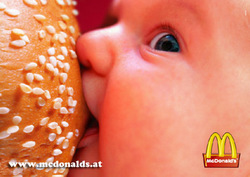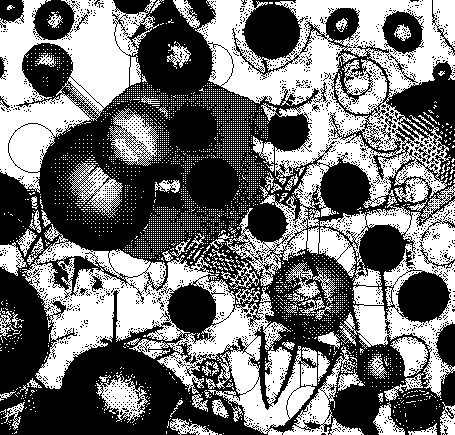View current page
...more recent posts

From Brian Turner's posts at WFMU's Beware of the Blog (originally from Stay Free! Daily). His caption is "McMother." Stay Free! says it's a real European McD0nald's ad and not a parody and I guess I believe it but yeesh.
Recipes
Lately I've been cable-surfing the Food Network and digging its sundry cooking "how-to" shows, especially the Japanese version of Iron Chef. [insert long-winded exegesis of show.] Technologically based arts need their equivalent; in fact visual artists lag behind chefs in the eclectic "mixing it up" aesthetic of current haute food prep. Musicians fare somewhat better in this regard because music software and gear matured sooner than imaging software and gear (i.e., it's been "there" longer to jack with), but both music and art improve when practitioners think outside the (software) box, that is, think like Iron Chef Sakai. I'm not saying I do this all the time, but certainly my instincts are to mix media and in the spirit of the food shows, I offer the following recipes for a recent animation (top) and musical effort (bottom). Eventually I'll write a Dogma-like manifesto that codifies these practices as the only right way to make art, but right now I'm still exploring and I haven't reached the really pedantic stage yet.
Example 1

"Abstraction with Two Centrifuges" (2004), animated GIF
Drawings in MSPaintbrush are printed out at different sizes (100% to 600%), cut up with (real) scissors, taped back together in a scrambled collage.Example 2
That piece is finished. The GIF above is a spinoff work, no pun intended.
Collage is photographed with digital camera, detail is cropped and enlarged in Photoshop, converted to greyscale, run through the threshold filter.
In MSPaint, photoshopped image is converted to black and white fill patterns under "image attributes." (MSPaintbrush won't do this without destroying the original image). New fill patterns and the "centrifuge molecules" are added in MSPaintbrush. Saved 8 times, each save becomes a frame, with a different stage of the spinning molecules.
Frames are animated in a GIF building program. Uploaded to web, border is added in html.
"One to Thirty" [6.8 MB .mp3]. The following discussion is pretty brand-intensive, and I apologize for that, but one point I guess I'm trying to convey is that no one piece of software or hardware "makes" the piece; it's mostly in the process.
A factory-programmed tune from the Korg Electribe Amkii (B04 "Techno 12") is slowed down from 125 to 99 bpm. Audio is run through a standard hardware mixing board at low volume. The MIDI out is played by another synth, the Sidstation (a factory preset patch called P73 "Pyramid"), also plugged into the board.The common point of both works is using a combination of programs, effects, changes in resolution, etc. to build up some kind of credible texture. The overall goal is to give sound and image creative integrity beyond their source programming. These recipes are mostly technical. There are content issues arising at various stages of the process, verbalized internally but ultimately best left for the individual to articulate (or not).
The Sid basically only reads one sustained note and some noise, everything else is filtered out.
That note plays over and over as pattern B04 cycles, and is bent in real time with a variety of knobs: (i) the Sid's continuous controllers, changing the cutoff filter and pitch, and (ii) the dials on an analog filter called the Mutator (see below).
All of the above sounds are recorded into the computer through the mixer. But first, the board sends and returns audio from both synths to the Mutator, which uses some sophisticated envelope controls to twist and interweave the two instruments in real time.
An audio part is recorded using an analog to digital recorder (I forget which): about a 7-minute .wav file of the knob-twiddling performance. The file is then edited down to 4.5 minutes in a .wav editor called GoldWave: redundant and/or out-of-tune parts are snipped out.
The .wav file is imported into Cubase, a sequencer program. The tempo track is set at 99 bpm.
The drum riff is a sample that ships with Beatburner, a (virtual) rhythm module plugged into Cubase. Several were tried before I arrived at this one--I may have added some effects processing to it, but probably not. I also tried a MIDI drum part playing various samples. Beatburner plays this drum and bass riff at 99 bpm and it's a decent fit with the existing audio.
Content-wise, what I had in mind was a contradiction between the one, bent note, which is sort of airy Steve Reich minimalism, and the "slammin'" forward movement of that dancefloor beat. No dropouts, crescendos or other dancefloor tricks were used. The piece is still pretty energetic, and might pass for drum and bass, although most of these dance tropes are pretty cliche at this point. [skip long-winded exegesis]
